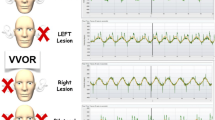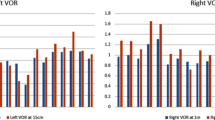Abstract
We studied optokinetic nystagmus (OKN), optokinetic afternystagmus (OKAN) and visual-vestibular interaction in five patients with markedly elevated vestibulo-ocular reflex (VOR) gain due to cerebellar atrophy. All had impaired smooth pursuit, decreased initial slow phase velocity of OKN, and impaired ability to suppress the VOR with real or imagined targets. OKN slow phase velocity gradually built up over 25–45 s, reaching normal values for low stimulus velocities (≤30 deg/s). Initial velocity of OKAN was increased, but the rate of decay of OKAN was normal. These findings can be explained by models that include separate velocity storage and variable gain elements shared by the vestibular and optokinetic systems.
Similar content being viewed by others
References
Aoki H, Yagi T, Kobayashi Y, Tomokazu K (1987) Effect of VOR gain changes on OKN gain control. In: Graham MD, Kemink JL (eds) The vestibular system: neurophysiologic and clinical research. Raven Press, New York, pp 489–491
Baloh RW, Langhofer L, Honrubia V, Yee RD (1980) On-line analysis of eye movements using a digital computer. Aviat Space Environ Med 51:563–567
Baloh RW, Yee RD, Honrubia V (1986) Late cortical cerebellar atrophy. Brain 109:159–180
Cohen B, Matsuo V, Raphan TH (1977) Quantitative analysis of the velocity characteristics of optokinetic nystagmus and optokinetic after-nystagmus. J Physiol (Lond) 270:321–344
Cohen B, Henn V, Raphan T, Dennett D (1981) Velocity storage, nystagmus, and visual-vestibular interactions in humans. Ann NY Acad Sci 374:421–433
Cohen H, Cohen B, Raphan T, Waespe W (1992) Habituation and adaptation of the vestibulo-ocular reflex: a model of differential control by the vestibulocerebellum. Exp Brain Res 90:526–538
Demer JL (1981) The variable gain element of the vestibulo-ocular reflex is common to the optokinetic system of the cat. Brain Res 229:1–13
Demer JL, Robinson DA (1982) Effects of reversible lesions and stimulation of olivocerebellar system on vestibuloocular reflex plasticity. J Neurophysiol 47:1084–1107
Dichgans J, Schmidt CL, Graf W (1973) Visual input improves the speedometer function of the vestibular nuclei in the goldfish. Exp Brain Res 18:319–322
Fletcher WA, Hain TC, Zee DS (1990) Optokinetic nystagmus and afternystagmus in human beings: relationship to nonlinear processing of information about retinal slip. Exp Brain Res 81:46–52
Greenfield JG (1954) The spino-cerebellar degenerations. Blackwell, Oxford
Hoffmann KP, Distler C (1986) The role of direction selective cells in the nucleus of the optic tract of cat and monkey during optokinetic nystagus. In: Keller EL, Zee DS (eds) Adaptive processes in visual oculomotor systems. Pergamon Press, Oxford New York, pp 261–266
Holmes G (1907) A form of familial degeneration of the cerebellum. Brain 30:466–489
Jell RM, Ireland DJ, Lafortune S (1984) Human optokinetic afternystagmus: slow-phase characteristics and analysis of the decay of slow-phase velocity. Acta Otolaryngol 98:462–471
Lafortune S, Ireland DJ, Jell RM, DuVal L (1986) Human optokinetic afternystagmus. Acta Otolaryngol 101:183–192
Lisberger SG, Miles FA, Optican LM, Eighmy BB (1981) Optokinetic response in monkey: underlying mechanisms and their sensitivity to long term adaptive changes in vestibuloocular reflex. J Neurophysiol 45:869–890
Lisberger SG, Miles FA, Zee DS (1984) Signals used to compare errors in monkey vestibulo-ocular reflex: possible role of flocculus. J Neurophysiol 52:1140–1153
Raphan T, Cohen B (1978) Brainstem mechanisms for rapid and slow eye movements. Ann Rev Physiol 40:527–552
Raphan T, Matsuo V, Cohen B (1979) Velocity storage in the vestibulo-ocular reflex arc. Exp Brain Res 35:229–248
Robinson DA (1976) Adaptive gain control of vestibuloocular reflex by the cerebellum. J Neurophysiol 39:954–969
Robinson DA (1977) Linear addition of optokinetic and vestibular signals in the vestibular nucleus. Exp Brain Res 30:447–450
Thurston SE, Leigh RJ, Abel LA, Dell'Osso LF (1987) Hyperactive vestibulo-ocular reflex in cerebellar degeneration. Neurology 37:53–57
Tijssen M, Straathof C, Hain TC, Zee DS (1989) Optokinetic after-nystagmus in normal subjects: normal values of amplitude, time constant and asymmetry. Ann Otol Rhinol Laryngol 98:741–746
Waespe W, Cohen B (1983) Flocculectomy and unit activity in the vestibular nuclei during visual-vestibular interactions. Exp Brain Res 51:23–35
Waespe W, Henn V (1977) Neuronal activity in the vestibular nuclei of the alert monkey during vestibular and optokinetic stimulation. Exp Brain Res 27:523–538
Waespe W, Cohen B, Raphan T (1983) Role of the flocculus and paraflocculus in optokinetic nystagmus and visual-vestibular interactions: effects of lesions. Exp Brain Res 50:9–33
Yee RD, Baloh RW, Honrubia V, Lau CGY, Jenkins HA (1979) Slow build-up of optokinetic nystagmus associated with downbeat nystagmus. Invest Ophthalmol Vis Sci 18:622–629
Zasorin NL, Baloh RW, Yee RD, Honrubia V (1983) Influence of vestibulo-ocular reflex gain on human optokinetic responses. Exp Brain Res 51:271–274
Zee D, Yee R, Robinson D (1976a) Optokinetic responses in labyrinthine-defective human beings. Brain Res 113:423–428
Zee DS, Yee RD, Robinson DA, Cogan DG (1976b) Ocular abnormalities in hereditary cerebellar ataxia. Brain 99:207–234
Zee DS, Yamazaki A, Butler PH, Gucer G (1981) Effects of ablation of flocculus and paraflocculus on eye movements in primate. J Neurophysiol 46:879–899
Author information
Authors and Affiliations
Rights and permissions
About this article
Cite this article
Baloh, R.W., Demer, J.L. Optokinetic-vestibular interaction in patients with increased gain of the vestibulo-ocular reflex. Exp Brain Res 97, 334–342 (1993). https://doi.org/10.1007/BF00228703
Received:
Accepted:
Issue Date:
DOI: https://doi.org/10.1007/BF00228703




